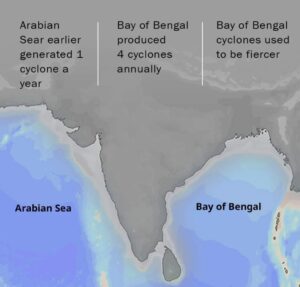In news: Recently extremely severe cyclonic storm Tauktae pummelled India’s western coasts from Kerala and Tamil Nadu to Maharashtra and Gujarat.
About frequency of Cyclones in Arabian Sea-
- It is the first major cyclone to originate in the Arabian Sea in 2021.
- As per convention, the average number of cyclones building in the north Indian Ocean has been five in a year and only one of the five usually emerge in the Arabian Sea.
- However, in 2018, while the Bay of Bengal maintained its average of four cyclones a year, the Arabian Sea produced three cyclonic storms.
- In 2019, the Arabian Sea overtook the Bay of Bengal with five cyclones to three.
- In 2020, the Bay of Bengal produced three cyclonic storms while the Arabian Sea generated two.
- Scientists have attributed the increased frequency of cyclones in the Arabian Sea to climate change.
- According to the Intergovernmental Panel on Climate Change (IPCC), the sea surface temperature of the Arabian Sea is rising.
- Since satellite records began in India in 1980, this is the first time that pre-monsoon cyclones have been recorded in the Arabian Sea for four consecutive years.
- The western tropical Indian Ocean has turned out to be the largest contributor to the overall trend in the global mean sea surface temperature (SST).
- As Indian ocean has absorbed 90% of the excess heat generated by greenhouse gas (GHG) emissions since 1970, it has led to anomalous ocean warming, which in turn makes cyclones intensify rapidly.

IMD classification of cyclones:
Cyclones are classified on the basis of the wind speed.
- The lowest official classification used in the North Indian Ocean is a Depression, which has a 3-minute sustained wind speeds of between 20–31 mph (31–50km/h).
- Deep Depression: If the depression intensifies further then it will become a Deep Depression, which has speeds of between 32–38 mph (51–62 km/h).
- Cyclonic storm: If the Deep Depression develops gale force wind speeds of between 39–54 mph (63–88 km/h), it is called a Cyclonic storm and the Indian Meteorological Department (IMD) assigns a name to it.
- Severe Cyclonic Storm: They have storm force wind speeds of between 55–72 mph (89–117 km/h).
- Very Severe Cyclonic Storm: They have hurricane-force winds of 73–102 mph (118–165 km/h).
- Extremely Severe Cyclonic Storm: They have hurricane-force winds of 104–137 mph (166–220 km/h).
Super Cyclonic Storm: The highest classification used in the North Indian Ocean which have hurricane-force winds of above 138 mph (221 km/h).
More information- The naming of cyclones – JournalsOfIndia
















